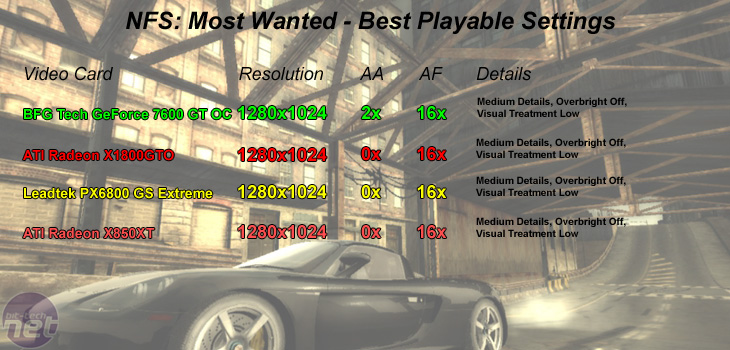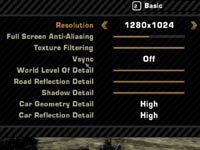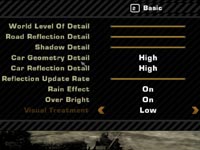Need For Speed: Most Wanted:
Publisher: Electronic ArtsWe used the full retail version of Need For Speed: Most Wanted patched to version 1.3. It's the latest addition to Electronic Arts' popular Need For Speed franchise. The game makes use of shaders everywhere, with realistic car reflections, a dynamic sky making use of HDR bloom and also weather patterns that change during the game. Most of the game takes place in the daytime, so aliasing is much more noticeable than it was in previous versions of the Need For Speed: Underground sub-franchise - antialiasing is preferred over a higher resolution in order to combat the edge aliasing.
There is a new setting called Visual Treatment which - when set to high - leaves a bright glow on most objects that get in the way of the sunlight. We feel this looks slightly unrealistic as the effect is over-used to an extent and it's best left set to the low setting with overbright enabled. Along with this, there's also the fact that the high setting causes a big performance drop, giving yet another arguement for leaving it on the lower setting.
We did a manual run through of the NFS World Loop sprint track that lasts for around 8 minutes. This is sufficient time to experience the rain effect and normal weather conditions in the same run through. The track gives a good idea of what NFS: Most Wanted will perform like on any card, as it goes around all regions of the world.


We had to reduce world detail, road reflection detail, shadow detail and reflection update rate down a notch to about two thirds of the maximum slider. We also had to turn overbright off and reduce car geometry detail and car reflection detail to 'medium'. We were still able to leave visual treatment set to 'low' though, this meant that there was still some dynamic lighting effects but they weren't quite as prominent as when overbright is enabled.
The BFG Tech GeForce 7600 GT OC was the fastest card in this test, as we were able to maintain a smooth and immersive gaming experience with 2xAA 16xAF at 1280x1024. At these settings, we were able to complete the 'World Loop' track with our frame rate never dropping below 30 frames per second.
The remaining three cards were all best playable at the same settings. We weren't able to apply antialiasing without the frame rate dropping to unacceptable levels where we started to experience frame rate lag and slow downs that made driving a little tougher than it is when the frame rate is smooth. Leadtek's PX6800 GS Extreme delivered a slightly smoother gaming experience than the ATI Radeon X1800GTO, with the Radeon X850XT being a little behind ATI's new kid on the block.

MSI MPG Velox 100R Chassis Review
October 14 2021 | 15:04








Want to comment? Please log in.